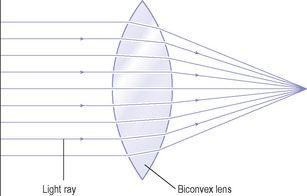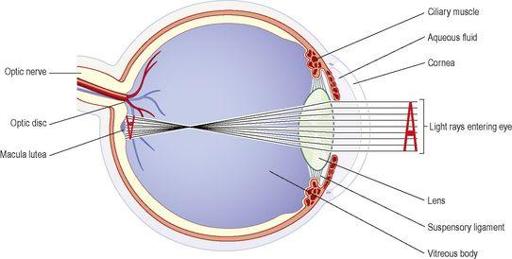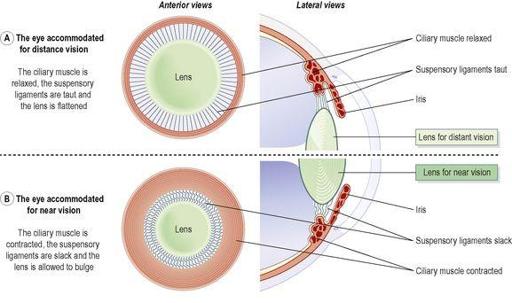Ross & Wilson Anatomy and Physiology in Health and Illness (89 page)
Read Ross & Wilson Anatomy and Physiology in Health and Illness Online
Authors: Anne Waugh,Allison Grant
Tags: #Medical, #Nursing, #General, #Anatomy

Figure 8.14
Refraction:
white light broken into the colours of the visible spectrum when it passes through a prism.
This range of colour is the
spectrum of visible light
. In a rainbow, white light from the sun is broken up by raindrops, which act as prisms and reflectors.
The electromagnetic spectrum
The electromagnetic spectrum is broad, but only a small part is visible to the human eye (
Fig. 8.15
). Beyond the long end are infrared waves (heat), microwaves and radio waves. Beyond the short end are ultraviolet (UV), X-rays and gamma rays. UV light is not normally visible because it is absorbed by a yellow pigment in the lens. Following removal of the lens (cataract extraction), UV light is visible and it has been suggested that long-term exposure may damage the retina.
Figure 8.15
The electromagnetic spectrum.
A specific colour is perceived when only one wavelength is reflected by the object and all the others are absorbed, e.g. an object appears red when only the red wavelength is reflected. Objects appear white when all wavelengths are reflected, and black when they are all absorbed.
In order to achieve clear vision, light reflected from objects within the visual field is focused on to the retina of each eye. The processes involved in producing a clear image are
refraction of the light rays
, changing the
size of the pupils
and
accommodation
(adjustment of the lens for near vision).
Although these may be considered as separate processes, effective vision is dependent upon their coordination.
Refraction of the light rays
When light rays pass from a medium of one density to a medium of a different density they are bent; for example, in the eye, the biconvex lens bends and focuses light rays (
Fig. 8.16
). This principle is used to focus light on the retina. Before reaching the retina, light rays pass successively through the conjunctiva, cornea, aqueous fluid, lens and vitreous body. They are all denser than air and, with the exception of the lens, they have a constant refractory power, similar to that of water.
Figure 8.16
Refraction of light rays passing through a biconvex lens.
Focussing of an image on the retina
Light rays reflected from an object are bent (refracted) by the lens when they enter the eye in the same way as shown in
Figure 8.16
, although the image on the retina is actually upside down (
Fig. 8.17
). The brain adapts to this early in life so that objects are perceived ‘the right way up’.
Figure 8.17
Section of the eye showing the focusing of light rays on the retina.
Abnormal refraction within the eye is corrected using biconvex or biconcave lenses, which are shown on
page 206
.
Lens
The lens is a biconvex elastic transparent body suspended behind the iris from the ciliary body by the suspensory ligament. It is the only structure in the eye that changes its refractive power. Light rays entering the eye need to be refracted to focus them on the retina. Light from distant objects needs least refraction and, as the object comes closer, the amount of refraction needed is increased. To increase the refractive power, the ciliary muscle contracts. This moves the ciliary body inwards towards the lens (contracts the sphincter), relaxing the pull on the suspensory ligaments, and allows the lens to bulge, increasing its convexity. This focuses light rays from near objects on the retina. When the ciliary muscle relaxes it slips backwards, increasing its pull on the suspensory ligament, making the lens thinner (
Fig. 8.18
). This focuses light rays from distant objects on the retina.
Figure 8.18
Accommodation: action of the ciliary muscle on the shape of the lens. A.
Distant vision.
B.
Near vision.
Size of the pupils
Pupil size influences accommodation by controlling the amount of light entering the eye. In a bright light the pupils are constricted. In a dim light they are dilated.
If the pupils were dilated in a bright light, too much light would enter the eye and damage the sensitive retina. In a dim light, if the pupils were constricted, insufficient light would enter the eye to activate the light-sensitive pigments in the rods and cones which stimulate the nerve endings in the retina.
The iris consists of one layer of circular and one of radiating smooth muscle fibres. Contraction of the circular fibres constricts the pupil, and contraction of the radiating fibres dilates it. The size of the pupil is controlled by the autonomic nervous system; sympathetic stimulation dilates the pupils and parasympathetic stimulation causes constriction.
Accommodation
Close vision
In order to focus on near objects, i.e. within about 6 metres, accommodation is required and the eye must make the following adjustments:
•
constriction of the pupils
•
convergence
•
changing the power of the lens.
Constriction of the pupils
This assists accommodation by reducing the width of the beam of light entering the eye so that it passes through the central curved part of the lens (
Fig. 8.17
).
Convergence (movement of the eyeballs)
Light rays from nearby objects enter the two eyes at different angles and for clear vision they must stimulate corresponding areas of the two retinae. Extrinsic muscles move the eyes and to obtain a clear image they rotate the eyes so that they converge on the object viewed. This coordinated muscle activity is under autonomic control. When there is voluntary movement of the eyes both eyes move and convergence is maintained. The nearer an object is to the eyes the greater the eye rotation needed to achieve convergence, e.g. an individual focusing near the tip of his nose appears to be ‘cross-eyed’. If convergence is not complete the eyes are focused on different objects or on different points of the same object. There are then two images sent to the brain and this leads to double vision,
diplopia
. If convergence is not possible, the brain tends to ignore the impulses received from the divergent eye (see
Squint, p. 204
).
Changing the power of the lens
Changes in the thickness of the lens are made to focus light on the retina. The amount of adjustment depends on the distance of the object from the eyes, i.e. the lens is thicker for near vision and at its thinnest when focusing on objects at more than 6 metres’ distance (
Fig. 8.18
). Looking at near objects ‘tires’ the eyes more quickly, owing to the continuous use of the ciliary muscle. The lens loses its elasticity and stiffens with age, a condition known as
presbyopia
(
p. 204
).
Distant vision
Objects more than 6 metres away from the eyes are focused on the retina without adjustment of the lens or convergence of the eyes.
Functions of the retina
The retina is the light-sensitive (photosensitive) part of the eye. The light-sensitive nerve cells are the rods and cones and their distribution in the retina is shown in
Figure 8.11A
. Light rays cause chemical changes in light-sensitive pigments in these cells and they generate nerve impulses which are conducted to the occipital lobes of the cerebrum via the optic nerves (
Fig. 8.13
).
The
rods
are much more light sensitive than the cones (see
Fig. 8.11
), so they are used when light levels are low. Stimulation of rods leads to monochromic (black and white) vision. Rods outnumber cones in the retina by about 16 to 1.
The
cones
are sensitive to bright light and colour. The different wavelengths of visible light light-sensitive pigments in the cones, resulting in the perception of different colours. In bright light the light rays are focused on the macula lutea. Colour blindness is a common condition that affects more men than women. Although affected individuals see colours, they cannot always differentiate between them as the light-sensitive pigments (to red, green or blue) in cones are abnormal. There are different forms but the most common is red-green colour blindness which is transmitted a by sex-linked recessive gene (see
Fig. 17.10, p. 434
) where greens, oranges, pale reds and browns all appear to be the same colour and can only be distinguished by their intensity.
The rods are more numerous towards the periphery of the retina.
Visual purple
(
rhodopsin
) is a light-sensitive pigment present only in the rods. It is bleached (degraded) by bright light and is quickly regenerated, provided an adequate supply of vitamin A is available.




